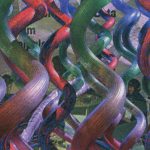Paras Kaul, Mark Applebaum: That Brain Wave Chick V
Artist(s):
Title:
- That Brain Wave Chick V
Exhibition:
- SIGGRAPH 2001: n-space
-
More artworks from SIGGRAPH 2001:


Creation Year:
- 2001
Medium:
- Performance
Category:
Artist Statement:
“Brain Wave Chick V” is a collaborative brain wave concert performance by Mark Applebaum and Paras Kaul. “The Ganglia’s All Here,” designed by Paras and Bill Vitucci, provides an animated background for the performance. This video incorporates 3D computer graphic animation and video motion graphics created using Alias|Wavefront Maya, Alias|Wavefront Composer, Adobe After Effects, and Adobe Photoshop. Roddy Schrock, music composer from Japan, will be technical assistant for the performance.
The neural environment, based on Paras’ research in neural audio imaging, is surrealistic and features sound sculptures, designed and played by Mark. These sculptures are the result of research begun by Mark in 1990. Since that time, he has engaged in the design and construction of sound-sculptures, musical instruments intended for their visual, as well as sonic properties. From the research, he has produced the mousetrap, the mini-mouse, the duplex mausphon, the midi-mouse, and six micro-mice, instruments consisting of junk, hardware, and found-objects mounted on electro-acoustic sound boards. The sound-sculptures are played with the hands, chopsticks, combs, plectrums, and a violin bow. Their sounds are acoustic, electro-acoustic (amplified via piezo contact pickups), and electronic (modified by external signal processors).
These instruments have been employed in “formal” compositions (such as “Zero-One,” performed by Steven Schick in Darmstadt, Germany, and “Scipio Wakes Up,” commissioned by the Paul Dresher Ensemble) as well as improvised works (such as a 1993 collaboration with the Merce Cunningham Dance Company), and the Innova CD Mousetrap Music.
During the performance, the nature of the external signal processing is determined by Paras’ brain waves, as interpreted by a MAX digital audio patch described below. Neural data are provided by Paras in real time via a brain wave interface system configured on her computer. Using this interface to the computer, Paras’ neural activity is transformed into real time MIDI data and transferred to Mark’s computers. The brain wave interface system is IBVA, which utilizes standard EEG monitoring of the neural activity. Amplitudes are converted to MIDI velocities and frequencies are converted to MIDI note numbers.
A MAX software “patch” examines the brain wave (MIDI) activity. Events may be left unchanged, filtered, distorted, transformed, modulated by other events or tendencies, responded to, etc. By choosing what to play and how, the patch circumscribes the audio aesthetic. The patch is “played” by Mark with a continuous MIDI controller, and by Paras through initial neural activity and by her responses to aural articulations. Variable in this collaboration are the activities of the two individuals as well as the patch; these engender results that vary from probable/stochastic to unpredictable/ random.
The video projected animation uses symbolism to represent a variety of mental states that are mimicked by Paras’ brain wave switching among frequency domains ranging from high beta, low beta, alpha, theta, and delta. A feedback loop exists between the three computer systems, two operated by Mark, and the other by Paras. The result of this process is a continuous play of communication between Mark and Paras.
Mark uses two Macintosh G3 computers. One computer will run the MAX patch that receives and modifies the midi data converted from Paras’ IBVA interface. It will trigger Yamaha EXSR, Proteus 2000, Oberheim Matrix-1000, and Kurzweil 1000PX sound modules. The second computer will run the MAX/MSP patch that modifies the signal processing of the sound-sculptures. This includes sound routed through various external processors as well as processing associated within the computer itself (via MSP) and output through a Digidesign 001 interface. External processors include a Lexicon MPXI, Electronix Filter Factory, Yamaha SPXSOD, Ibanez DM1000, Korg SDD-2000, DOD DI2, BBE422A, Roland VP-70, and Roland RE-301. Data on two computers will be modified by a Peavey 1600X midi controller.
The Animation
The animation provides a moving background for the performance. The frequency of events in the animation, color, and symbology are designed to reflect a variety of mental states. Paras will mimic brain wave states reflected in the animation. During calm sections, her brain wave activity will reflect the low frequencies and low amplitudes of alpha and theta signals. When the animation is chaotic in nature, she will switch brain wave signals to higher beta frequencies and amplitudes. Since the brain wave signaling directly effects the audio, a direct correlation will exist between the audio and visuals.






